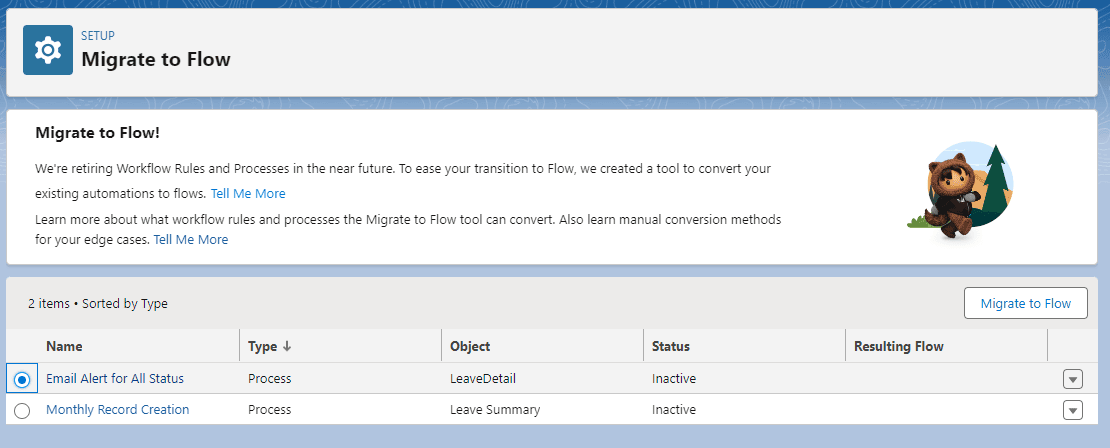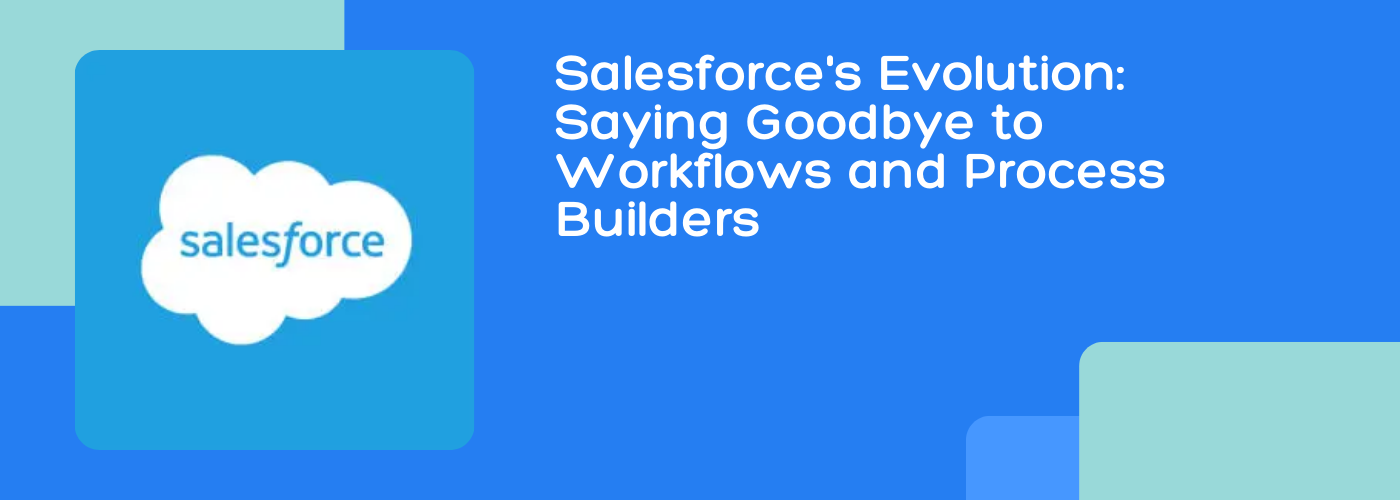Welcome To The Future Of Automation with Salesforce
As we navigate through the ever-evolving tech landscape, one truth remains: change is inevitable. Salesforce, a leader in cloud computing, is embracing this change by transitioning from its classic tools, Workflows and Process Builders to something more contemporary and efficient. But fear not—this transition is less of an end and more of a beginning.
In this post, we’ll demystify Salesforce’s decision and guide you through this transition with an easy-to-understand example, making it feel more like an upgrade than a farewell.
This move is inspired by the growing demands of businesses for more dynamic and versatile automation capabilities. While Workflows and Process Builders have been faithful in their service, the introduction of Flow marks a new era of automation possibilities. It’s about enhancing flexibility and efficiency in automation like never before.
Salesforce has updated its automation tool guidance, signaling a clear direction for its users:
“Flow Builder is now the go-to for all your automation needs,” according to Salesforce Help and Trailhead: Choose the Right Automation Tool.
Let’s dive into this exciting journey together, exploring how this shift will redefine automation in the Salesforce ecosystem.
The Age Of Workflows And Process Builders:
Consider Workflow Rules and Process Builders as the pioneers of automation.
Reflecting on the past, let’s revisit the period when Workflows and Process Builders dominated the Salesforce environment. Serving as dependable allies, they streamlined processes and enhanced productivity. Nonetheless, as technology evolves, Salesforce acknowledges the demand for more robust, adaptable, and efficient solutions.
The Evolution Of Salesforce’s Automation Heroes:
In the narrative of Salesforce’s transformation, think of it as a vibrant metropolis once safeguarded by two valiant heroes—Worky the Workflow and Procy the Process Builder.
Worky the Workflow was adept at handling routine tasks effortlessly, yet, he occasionally found himself at odds with more intricate challenges.
Procy the Process Builder, while proficient in managing a variety of processes, wasn’t as effective when it came to large volumes of data.
Enter the scene, a new era superhero, Flo the Flying Squirrel, introduced by Salesforce as the face of modern automation capabilities.

“Flo – Flow” serves as the master conductor of the city, effortlessly orchestrating intricate operations.
Introducing Flow: The Vanguard of Automation
Flow represents the zenith of automation capabilities within Salesforce, akin to a technological Iron Man. Its advanced features and formidable functionality enable everything from crafting personalized birthday greetings to facilitating seamless integration between your CRM and external applications. Below we detail how Flow excels beyond its predecessors:
Supercharged Automation: Flow excels in managing complex workflows and processes with unmatched efficiency, ushering in a new era of organizational productivity.
Data Mastery: Flow ensures smooth and dependable management of large data sets through its bulk data operation capabilities.
Unified Experience: Flow offers a unified and simplified interface, making the management of complex tasks more intuitive and streamlined than ever before.
Superpowers Beyond Imagination: With Flow, users can create sophisticated automations incorporating detailed logic, complex data operations, and robust error handling. It effectively places an automation expert at your disposal.
Friendship across the Digital Universe: Diverging from the limitations of Workflow Rules and Process Builders to the Salesforce environment, Flow boasts extensive compatibility with external platforms. It achieves seamless interaction across services via API calls, ensuring a cohesive operational ecosystem.
Scale Up, Not out: Where managing a multitude of Workflow Rules and Process Builders could become unwieldy, Flow introduces efficiency through sub-flows, enhancing the manageability and scalability of complex automations as your business grows.
Learning Made Easy: Flow’s intuitive drag-and-drop interface makes it accessible for automation novices and experts alike, akin to having a personal guide through the intricacies of automation, maximizing the platform’s capabilities.
Additional Resources:
Salesforce Flow: https://help.salesforce.com/s/articleView?id=sf.flow.htm&language=en_US&type=5
Keep in mind that adopting Flow may require some adjustment period, yet it represents an investment in a more efficient and potent method of automating your Salesforce tasks.
– Help and Training Community, Salesforce
Is the eventual retirement of Workflow Rules and Process Builder approaching, and what is the timeline for this transition?
Phase 1: Beginning with Salesforce Winter ’23 in October 2022, the creation of new Workflow Rules will be gradually phased out.
Phase 2: Following this, as of Salesforce Spring ’23 in February 2023, the creation of new Process Builders will be discontinued.
Phase 3: The anticipated end of support for Workflow Rules and Process Builder is scheduled for 2025.
Throughout Phases 1 and 2, while the creation of new Workflow Rules and Process Builders will cease, existing ones can still be utilized. However, as Phase 3 unfolds, support for these tools will come to an end.
Phase 4: Looking forward, Salesforce intends to completely retire Workflow Rules and Process Builder automation.
Please note: While dates are subject to change, the commitment to retiring these tools remains steadfast.
Flow embodies the future of Salesforce automation as the advanced tool set to redefine how automation is implemented. It overcomes any limitations its predecessors faced, positioning itself as the top choice for Salesforce Automation.
Feeling overwhelmed? No need to stress! Salesforce has developed conversion tools designed to ensure a smooth migration from Workflow Rules and Process Builder to Flow.

Final Reflections
In the ever-changing world of technology, Salesforce’s decision to phase out Workflows and Process Builders marks a deliberate step towards a platform that is not only powerful but also adaptable and efficient. As participants in this journey, we are not just observers; we play a central role in this ongoing story of progress. It’s time to bid adieu to the old guard and welcome the new with open arms – after all, the Salesforce ecosystem is on the brink of revealing its greatest advancements yet!
Automation stands for quick action and consistent outcomes. Flo, with his zest for productivity, embodies this spirit perfectly. He’s always on the move, tirelessly working to enhance the lives of those around him. – Salesforce
Curious to explore more about flows? You’re in luck! I wouldn’t dream of leaving you in suspense. For a thorough grasp of the topic, I encourage you to check out the official flow documentation on Trailhead. Immerse yourself in the detailed examples offered in this trail to deepen your understanding:
Follow these examples, and you’ll be thanking me later!


